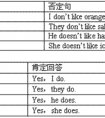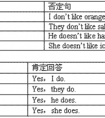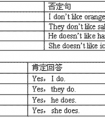根据要求改写句子。1. Yes, Icandothehousework.(对此句进行提问) 2. Mikecansweepthefloor.(改成否定句) 3. Herfavouritefoodisfish.(对划线部分提问)4. are forveg-五年级英语
Who is your teacher? 谁是你的老师?
三、特殊的答语。
特殊疑问句不能用yes, no来回答,而应根据它所询问的内容直接做出回答才行。如:
— What time is it, please? 请问几点了?
— It's 7:30. 七点半了。
— Where are they? 他们在哪儿?
—They're in the playground. 他们在操场上。
—What's your favorite subject? 你最喜爱的科目是什么?
—English. 英语。
四、 特殊的语调。
一般情况下,特殊疑问句要用降调(↘)来读。如:
Who's ↘that?
How old is↘Jack?
特殊疑问句有两种语序:
1.如疑问词作主语或主语的定语,即对主语或主语的定语提问,其语序是陈述句的语序:
Who is singing in the room﹖
whose bike is broken﹖
2.如疑问词作其他成分,即对其他成分提问,其语序是:
特殊疑问词+一般疑问句【特殊疑问词+be/助动词/情态动词+主语+谓语】
What does she like?
What class are you in﹖
Where are you from﹖
What time does he get up every morning﹖
How do you know﹖
小学对特殊疑问句的考查主要采取对划线句子提问的方式,那么在句型转换就划线部分提问的基本方法是:
先根据划线部分词语的意思和句法功能确定用什么疑问词;
然后将原句变为一般疑问句跟在疑问词的后面即可(注意去掉划线部分)。
基本构成:疑问词+一般疑问句
A、对“物”划线用What。
This is an orange. → What is this?
We can see a cat under the desk. → What can you see under the desk?
B、对“地点”划线用Where,如果“地点”作定语时,用Which后跟被修饰的那个名词。
He is under the tree. → Where is he?
Jenny is in the classroom. → Where is Jenny?
C、对“年龄”划线用How old。
Miss Li is twenty-three. → How old is Miss Li?
My sister is five years old. → How old is your sister?
D、对“颜色”划线,用What colour。
Her sweater is red. → What colour is her sweater?
E、对“可数名词的数量”划线用How many +复数名词。
She has one red coat. → How many red coats does she have?
I have six books. → How many books do you have?
F、对“不可数名词的数量”划线用How much+不可数名词。
I want to buy three kilos of meat. →How much meat do you want to buy?
G、对“职业”划线用What。
She is a driver. → What is she?
My father is a farmer. → What is your father?
H、对“星期几”划线用What day。
It's Sunday today. → What day is it today?
I、对“时间”划线用What time。
We go to school at seven in the morning. → What time do you go to school in the morning?
It is five o’clock now. → What time is it?
考点名称:固定搭配
- 固定搭配:
即不完全按照词组搭配的词性规则,约定俗称的固定组合方式。 小学常见固定搭配讲解:
(1)would like 意为“想,想要”,与want意义相同,但语气更委婉。
would like可与任何人称连用,没有人称和数的变化,肯定句中would常在主语后面缩写为’d。
A、肯定句:主语+ would like
I'd like two sweaters for my daughters. 我想给我的女儿们买两件毛衣。
I would like to drop maths. 我想放弃数学。
B、一般疑问句:Would +主语+ like?
回答是的两种结构:Yes, please. / No, thanks.
— Would you like a cup of tea? 你想要喝茶吗?
— Yes, please. 好的。/ No, thanks. 不用了,谢谢。
C、特殊疑问句:疑问词+ would + 主语+ like?
What would you like me to do? 你想要我干什么?
基本用法:
A、would like sth. “想要某物”。如:
— Would you like a cup of tea? 你想要喝茶吗?
— Yes, please. 好的。/ No, thanks. 不用了,谢谢。
B、would like to do sth. “想要做某事”。如:
— Would you like to go shopping with me? 你想和我一起去购物吗?
— Yes, I’d like to. 好的,我想去。
— I’d like to, but I have to do my homework. 我想去,但是我要做作业。
C、would like sb to do sth. “想要某人做某事”。
Jim would like his friend to help him with his English. 吉姆想要他的朋友帮助他学习英语。
(2)too……to:
“ too+形容词/副词+动词不定式”结构简称为“too……to”结构。
这种结构是英语中常用的一种句型,在大多数情况下表示否定意义,在翻译时,通常可译为“太……而不能……”、“太……无法……”。
A、too+adj. / adv.+to do这个句型是too……to的最基本的常用句型。too+形容词或副词,有时too后也可跟一个起形容词作用的过去分词。
例:The boy is too young to go to school. 这男孩年龄太小,不能上学。
The hat is too large to wear. 这帽子太大,没法戴。
The tea is too hot to drink. 茶太热,不能喝。
B、too+adj. / adv.+for sb. / sth. to do 在“too……to”结构中加上一个for sb ./ sth.以提示动词不定式的逻辑主语,可以起到一定的限制作用,即限制不定式所表示的动作行为只是就它的逻辑主语而言的,对于其他人或物则不一定是这样,这就使句子意思更具体、明白。
例:English is too difficult for me to learn well. 英语太难,我学不好。(具体指出谁学不好,只是我学不好,可能别人学得好。)
This box is too heavy for me to carry. 这个箱子太重,我搬不动。
It's too late for us to catch the early bus. 太晚了,我们赶不上那趟早班公共汽车了。- 小学常用英语固定搭配:
一.牛津小学英语涉及的动词不定式:
It’s time to do.该做某事了。
want to do=would like to do 想要做某事
go /come to do 去/来做某事
how to do 怎样做某事
try to do 试着做某事
need to do 需要做某事
forget to do 忘记做某事
二.动名词
No + doing 禁止做某事
like doing 喜欢做某事
How about doing…? 做某事怎么样
see sb.doing sth. 看见某人正在干某事
三.其余常用固定词组:
1.like+名词复数 (喜欢某物)
like doing /like to do (喜欢做某事)
2.would like sth.=want sth. (想要某物)
would like to + do=want to + do (想要做某事)
3.
① know a lot about sth. (了解很多关于…)
②talk to sb. about sth. (和某人谈论某事)
③talk about sth. (谈论某事)
④talk to /with sb. (和某人交谈)
⑤ask sb.questions about sth.(问某人关于某事的问题)
⑥ask sb. to do sth. (要求某人做某事)
⑦ tell sb. about sth. (告诉某人关于某事)
⑧ help sb.(to) do sth. (帮助某人做某事)
⑨ let sb. do sth. (让某人做某事)
4.
①give sb. sth.=give sth. to sb. (给某人某物--把某物给某人)
②show sb. sth. =show sth. to sb.(给某人看某物--把某物给某人看)
③buy sb. sth.= buy sth. for sb. (为某人买某物—买某物给某人)
5.pick it/them up 把它(它们)捡起 (it, them 只能放中间)
pick the book up = pick up the book 把书捡起 (具体东西可放中间也可放后面)
6.时间表达法:
at + 钟点(还有些固定搭配at night)
on +具体某一天(如星期几,星期几上午下午或几月几号)
in +月份或年(还有些固定搭配如 in themorning/afternoon/evening)
- 最新内容
- 相关内容
- 网友推荐
- 图文推荐
| [家长教育] 孩子为什么会和父母感情疏离? (2019-07-14) |
| [教师分享] 给远方姐姐的一封信 (2018-11-07) |
| [教师分享] 伸缩门 (2018-11-07) |
| [教师分享] 回家乡 (2018-11-07) |
| [教师分享] 是风味也是人间 (2018-11-07) |
| [教师分享] 一句格言的启示 (2018-11-07) |
| [教师分享] 无规矩不成方圆 (2018-11-07) |
| [教师分享] 第十届全国教育名家论坛有感(二) (2018-11-07) |
| [教师分享] 贪玩的小狗 (2018-11-07) |
| [教师分享] 未命名文章 (2018-11-07) |



![—Can you swim?—Yes ,________[ ] A. I can'tB. I canC. I am-三年级英语](http://www.00-edu.com/d/file/ks/4/1/46/2019-08-24/smallae208768e77b392cb00a5a8a687f84961566582505.jpg)
![_____________ I see that toy panda? [ ]A. canB. mayC. May-五年级英语](http://www.00-edu.com/d/file/ks/4/1/46/2019-08-24/small440f55b4860d5c9b87889948786e71451566582371.jpg)

